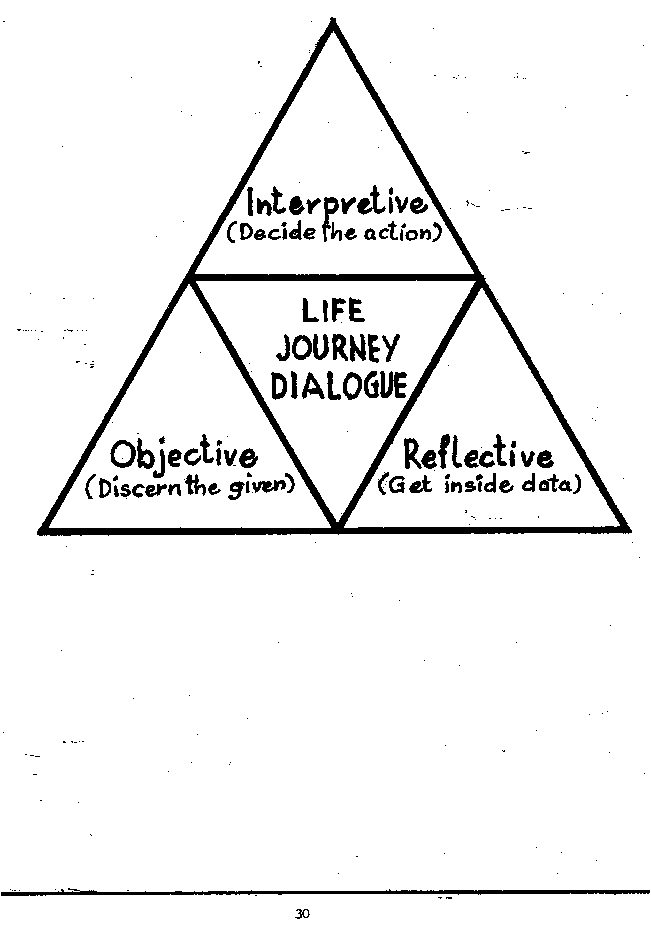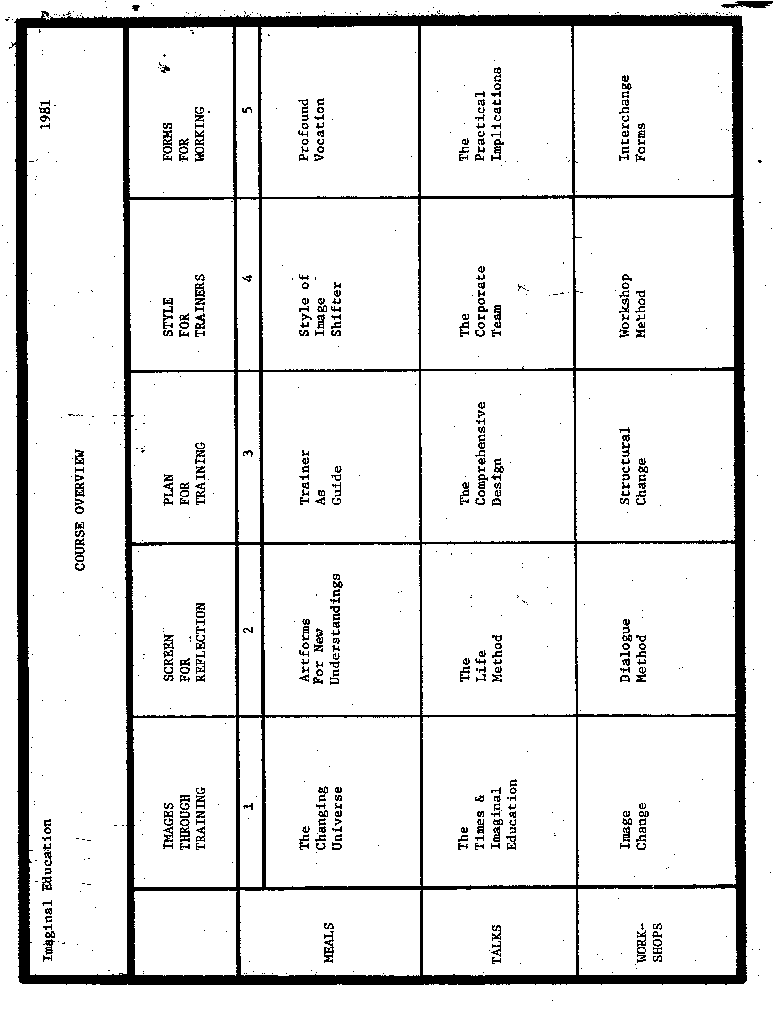
IMAGINAL
EDUCATION
MANUAL
Global Operations Centrum:
Chicago
Quarter II, 198182
Imaginal Education 1981
1981
Course Overview
Course OverviewPublic School Teachers
Meal Constructs
Intent of Workshops
2
3
4
SESSION I
Meal Construct The Changing Universe
Talk 4X4 The Times and Imaginal Education
Talk Summary
Back up Notes for Talk
Reading with TalkJourney to Ixtlan
Board Images for Talk
Workshop Image Change
Workshop Form
Workshop Public School Teachers Charting
The Image by Kenneth Boulding (edited version)
12 17 18 19 20
SESSIQN II
Meal Construct Art Forms For New Understandings
The Long H1andled Broom
Talk 4X4 The Life Method
Talk Summary
Reading with Talk The Immense Journey
Board Images for Talk
Workshop Dialogue Method
Workshop Forms
21
22
25
26
27
28
31
32
SESSION III .
Meal Construct. Trainer as Guide
Talk 4X4 The Comprehensive Design
Talk Summary
Reading with Talk Antigone
Back up for Board Image Life Triangles
Back up for Talk
Workshop Structural Change
Workshop Form
Workshop Pub. School TeachersBuilding Curriculum Design
35 36 37 38 39 40 43 45
SESSION IV
Meal Construct Style of the Image Shifter
Talk 4X4 The Corporate Team
Talk Summary
Reading with Talk The Circus of Dr. Lao
Workshop Workshop Method
Workshop Public School Teachers Building a Lesson Plan
Workshop Form PST
49
50
51
52
54
8
9
6
7
46 47
Workshop Form PST
56
57
SESSION V
Meal Construct Profound Vocation
Talk 4X4 The Practical Implications
Talk Summary
Reading with Talk Journey to Ixtlan
Workshop Interchange Forms
59 60 61 62 64


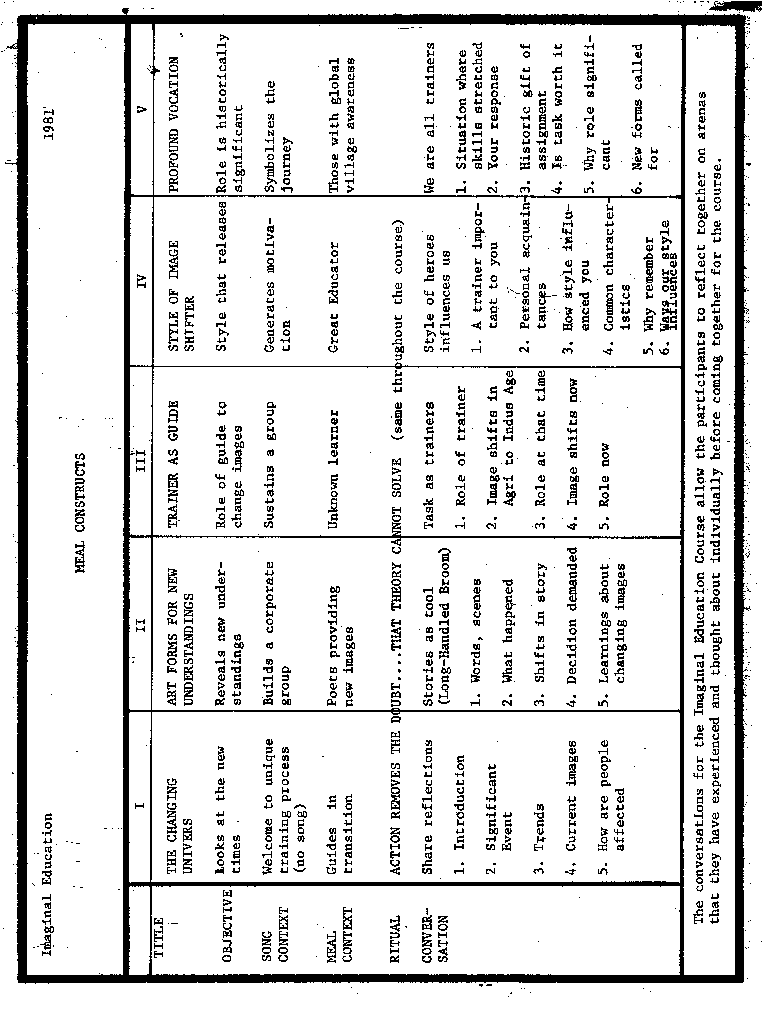 Imaginal Education 1981
Imaginal Education 1981
INTENT OF WORKSHOPS
I. IMAGE CHANGE
Rational Objective: To see the images that determine behavior and to discover messages that change images.
Existential Aim: To experience the possibility of
beaming messages (as trainers) that alter behavior.
II. DIALOGUE METHOD
Rational Objective: To practice the life method of reflection.
Existential Aim: To see the possibility of reflecting
in depth in any situation.
III. STRUCTURAL CHANGE
Rational Objective: To develop the skill of determining the intent
of a training design or curriculum.
Existential Aim: To experience the ability to determine what is to
happen to the participants in a training scheme.
IV WORKSHOP METHOD
Rational Objective: To observe the role of eventfulness in planning each training session.
Existential Aim: To experience the power that eventfulness
produces in a single event.
V. INTERCHANGE FORMS ,
.
Rational Objective: To create the tools for communicating image changing messages.
Existential Aim: To experience the excitement of returning to the job with image changing tools.
:
Imaginal Education
1981
MEAL
OBJECTIVE
RATIONAL OBJECTIVE
To understand the radical nature of the shift of the universe in our time.
EXISTENTIAL AIM
.
To experience thenecessity and option of continually updating one's understanding of the world and one's self.
CONTEXT
Welcome to Imaginal Education. We want to invite you to participate in a different type of educational course. We will be involved in the training process and then look at the theory behind that involvement.
SONG
(Most new groups would not be ready for a song at the beginning.)
RITUAL
For each meal we will participate in a common rite that states one of the key principles of Imaginal Education. Please repeat after me:
ACTION REMOVES THE DOUBT THAT THEORY CANNOT SOLVE
.
MEAL
Let us eat this meal on behalf of those people who have seen themselves chosen to guide societies through times of transition.
CONVERSATION
During our meals we will be taking time to get acquainted and
share our reflections about some of our concerns as educators.
(trainers)
objective
reflective
interpretive
t. Name and location: community or institution
2. Name the most significant event in the world during the last 5 years.
3. What are the changes taking place; or what are the trends these events are pointing to?
4. What are the images people are living out of?
5. How are people being affected by the changes in our time?
ANNOUNCEMENT
SEND OUT
Repeat the ritual we began with:
ACTION REMOVES THE DOUBT THAT THEORY CANNOT SOLVE.
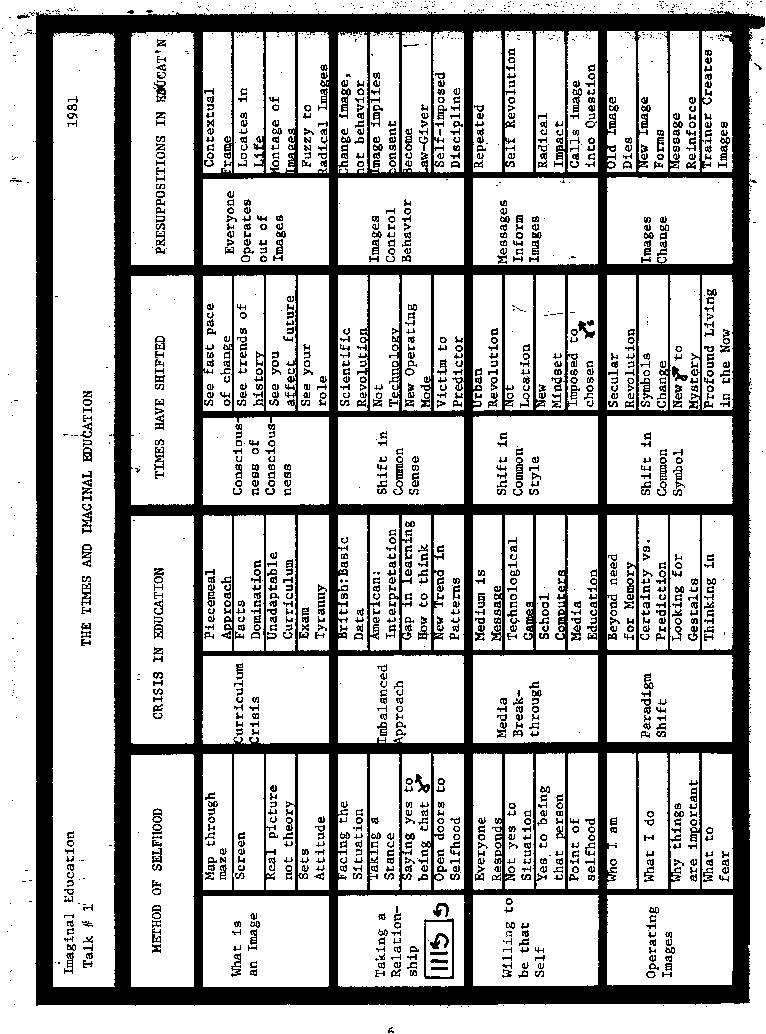 Imaginal Education l981
Imaginal Education l981
TALK SUMMARIES #1
A. METHODS OF SELFHOOD
An image is the picture or scene you think of when a crisis (or situation that demands a response) is before you, ie, You are asked to walk to the bus stop in a dangerous neighborhood and images or scenes appear in your mind as to possible dangers and responses you may make. These are the images you live out of. They are not theory or even thought through. They are the pictures that come to mind that will influence your decision on if and how you walk to the bus stop. Or in a more simple mode, someone talks about courage and you have images in your mind of situations, people, pictures of what this word conveys to you. A self is one who can stand outside these images and decide how to relate to them and what decision will be most helpful. Soren Kierkegaard gave us the formula that the process of selfhood involves you facing the situations, taking a relationship to
it and then willing to be that self thus freeing
you from either being a victim to your relationship or your situation
or from denying that such a relationship did take place. Our operating
images are from the questions of "Who I Am, What I Do, Why
things are important, and What to fear."
B.CRISIS IN EDUCATION
The piecemeal approach in education, where everyone
learns a bit of data that will later fit together like a puzzle,
no longer work. Learning facts have not taught ~eo'le to use those
facts. People are demanding to learn the process of education,
how to think, not what to think. The British system emphasized
the factual memorization to the exclusion of adaptability. The
American system emphasized the interpretation of things to the
exclusion of the basic data. No educational system balanced the
need for factual knowledge, the value screen and the interpretive
process since the Renaissance Era with common understanding of
society. There is a paradigm shift in education from learning
for certainty to learning for prediction.
C. TIMES HAVE SHIFTED
History has gone through 3 mayor shifts: from precivilization
(a time of memory and survival to civilization (the manipulation
of the universe) to post-civilization (the time of consciousness
of consciousness, when we are aware that we do change the trends
of history by selfconscious participation in it) There have
been 3 revolutions in the 20th Century that have signaled this.
The Scientific Revolution when reality is no longer seen as objective
views or personal opinion but as the perspective you choose which
then names and creates the very reality you see. The Urban Revolution
when style has become formed by the complex and multi-focused
relationships and problems. And the Secular Revolution, where
the symbols of what it means to live a fulfilled life are now
sp for grabs.
Everyone operates out of images; those that give you a context for operating, those that give you a gestalt or pattern for seeing; and those that give you basic affirmative attitudes for saying yes to life. These images control your behavior so if your image tells you you are not creative, then you don't act creative. Messages control images. Messages are our structures of time, space, and relationships that inform you if your images are true or not. If people pay no attention to you in a talk, they are reinforcing your image that you have nothing to say. Finally, images can change. The old image can die and an image that relates you to life in its wholeness can replace it. The educator is the one who creates the image for the trainee so they can learn as a self.
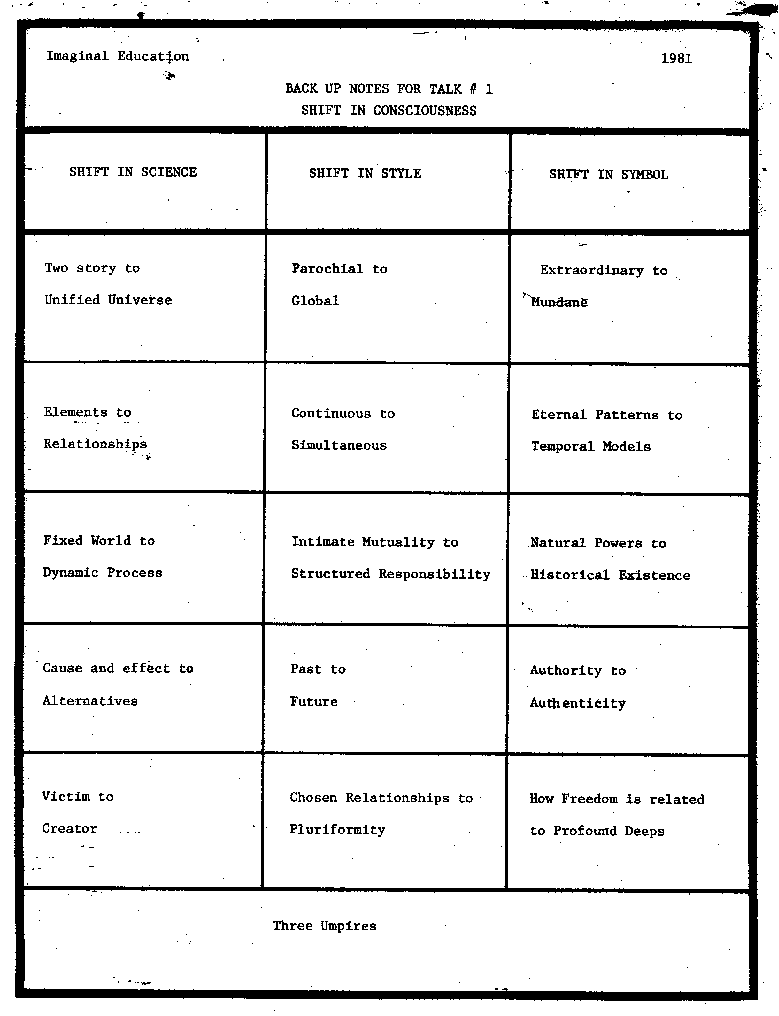 Imaginal Education; 1981
Imaginal Education; 1981
READING WITH TALK # 1
I told him the story of my father, who used to give
me endless lectures about the wonders of a healthy
mind in a healthy body, and how young men should temper their
bodies with hardships and with feats of athletic competition.
He was a young man; when I was eight years ol* he was only twentyseven.
During the summertime. as a rule, he would come from the city,
where he taught school, to spend at least a month with me at my
grandparents' farm, where I lived. It was a hellish month for
me. I told don Juan one instance of my father's behavior that
I thought would apply to the situation at hand.
Almost immediately upon arriving at the farm my father
would insist on taking a long walk with me at his side, so we
could talk things over, and while:we were talking he would
make plans for us to go swimming, every day at six AM. At night
he would set the alarm for fivethirty to have plenty of
time, because at six sharp we had to be in the water. And when
the alarm would go off in the morning, he would jump out of bed,
put on his glasses, go to the window and look out. Ihad
even memorized the ensuing monologue.
"Uhm...A bit cloudy today. Listen I'm going to lie down again for just five minutes. O.K.? No more than five! I'm just going to stretch my muscles and fully wake up."
He would invariably fall asleep again until ten,
sometimes until noon.
I told Don Juan that what annoyed me was his refusi1
to give up his obviously phony resolutions. He would repeat this
ritual every morning until I would: finally hurt his feelings
by refusing to set the alarm clock.
"They were not phony resolution," Don Juan
said, obviously taking sides with my father. "He just didn't
know how to get out of bed, that's all."
"At any rate," I said, "I'm always
leery of unreal resolutions."
"What would be a resolution that is real then?"
don Juan asked with a coy smile.
"If my father would have said to himself that
he could not go swimming at six in the morning but perhaps at
three in the afternoon."
"Your resolutions injure the spirit," don
Juan said with an air of great seriousness.
I thought I even detected a note of sadness in his
tone. We were quiet for a long time. My peevishness had vanished.
I thought of my father.
He didn't want to swim at three in the afternoon.
Don't you see?" Don Juan said.
His words made me jump.
I told him that my father was weak, and so was his
world of ideal acts that he never performed. I was almost shouting.
Don Juan did not say a word. He shook his head slowly in a rhythmical way. I
Imaginal Education 1981
JOURNEY TO IXTLAN - ASSUMING RESPONSIBILITY
pg. 2
felt terribly sad. Thinking of my father always gave me a consuming feeling.
. .
"You think you were stronger, don't you?"
he asked in a casual tone.
I said I did, and I began to tell him all the emotional
turmoil that my father had put me
through, but he interrupted me.
"Was he mean to you?" he asked.
"No."
"Was he petty with you?"
"No."
"Did he do a}1 he could for you?"
"Then what was wrong with him?"
Again I began to shout that he was weak, but I caught myself and lowered my voice. I felt a bit ludicrous being cross examined by Don Juan.
. .
"What are you doing all this for?" I said, "We were supposed to be talking about plants."
. .
I felt more annoyed and despondent than ever. I told
him that he had no business or the remotest qualifications to
pass Judgment on my behavior, and he exploded into a belly laugh.
"When you get angry you always feel righteous,
don't you?" he said and blinked like a bird.
He was right. I had the tendency to feel Justified
at being angry.
"Let's not talk about my father," I said,
feigning a happy mood. "Let's talk about plants."
"No, let's talk about your father," he
insisted. "That is the place to begin today. If you think
that you were so much stronger than he, why didn't you go swimming
at six in the morning in his place?"
I told him that I could not believe he was seriously
asking me that. I had always thought that swimming at six in the
morning was my father's business and not mine.
"It was also your business from the moment you
accepted his idea," don Juan snapped.
I said that I had never accepted it, that I had always known my father was not truthful to himself. Don Juan asked me matteroffactly why I had not voiced my opinions at the time.
. Imaginal Education 1981
JOURNEY TO IXTLAN -- ASSUMING RESPONSIBILITY
pg. 3
"You don't tell your father things like that."
I said, as a weak explanation.
"Why not?"
"That was not done in my house, that's all."
"You have done worse things in your house,"
he declared like a judge from the bench. "The only thing
you never did was to shine your spirit."
There was such a devastating force in his words that
they echoed in my mind. He brought all my defenses down. I could
not argue with him. I took refuge in writing my notes.
I tried a last feeble explanation and said that all
my life I had encountered people of my father's kind, who had,
like my father, hooked me somehow into their schemes, and as a
rule I had always been left dangling.
"You are complaining," he said softly.
"You have beencomplaining all your life because you
don't assume responsibility for your decisions. If you would have
assumed respodsibility for your father's idea of swimming at six
in the morning, you would have swum, by yourself if necessary,
or you would have told him to go to hell the first time he opened
his mouth after you knew his devices. But you didn't say anything.
Therefore, you were as weak as your father.>
"To assume the responsibility of one's decisions
means that one is ready to die for them."
. !
_ .
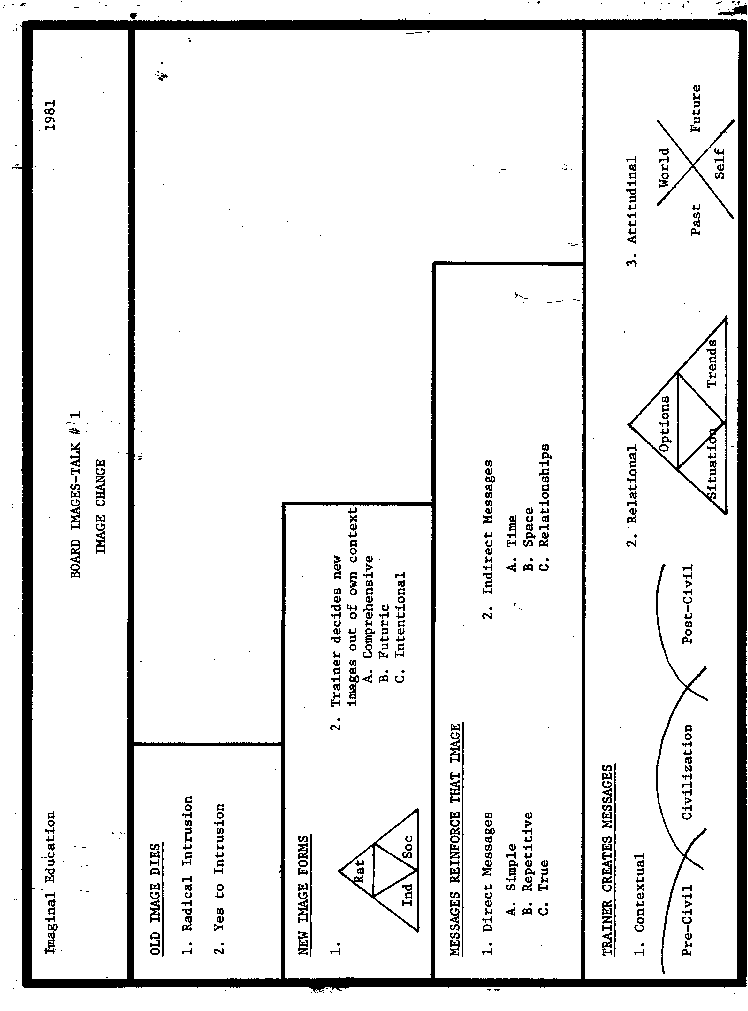
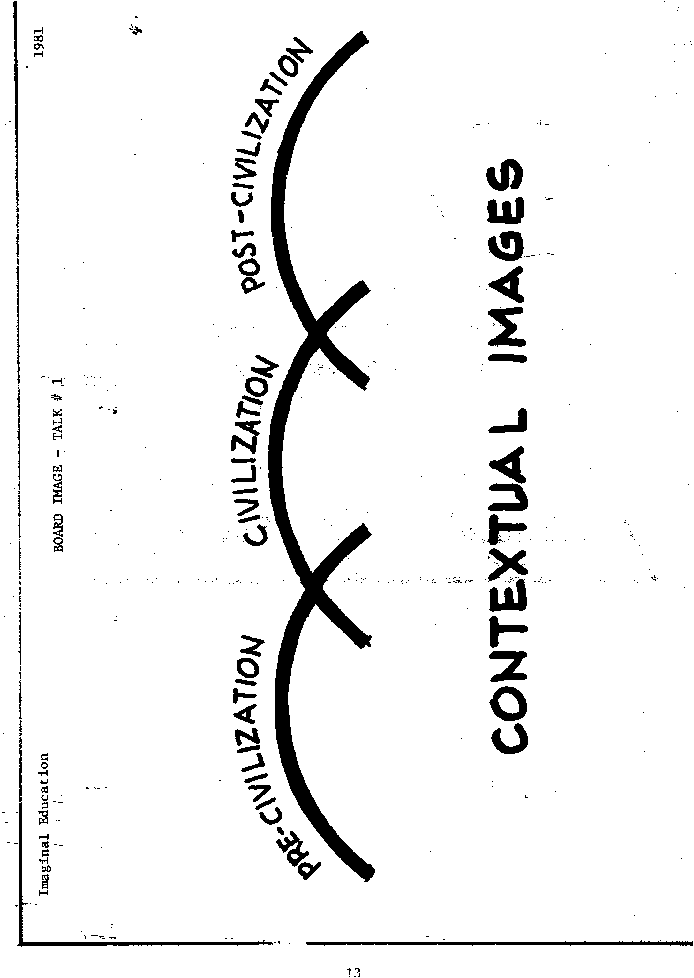
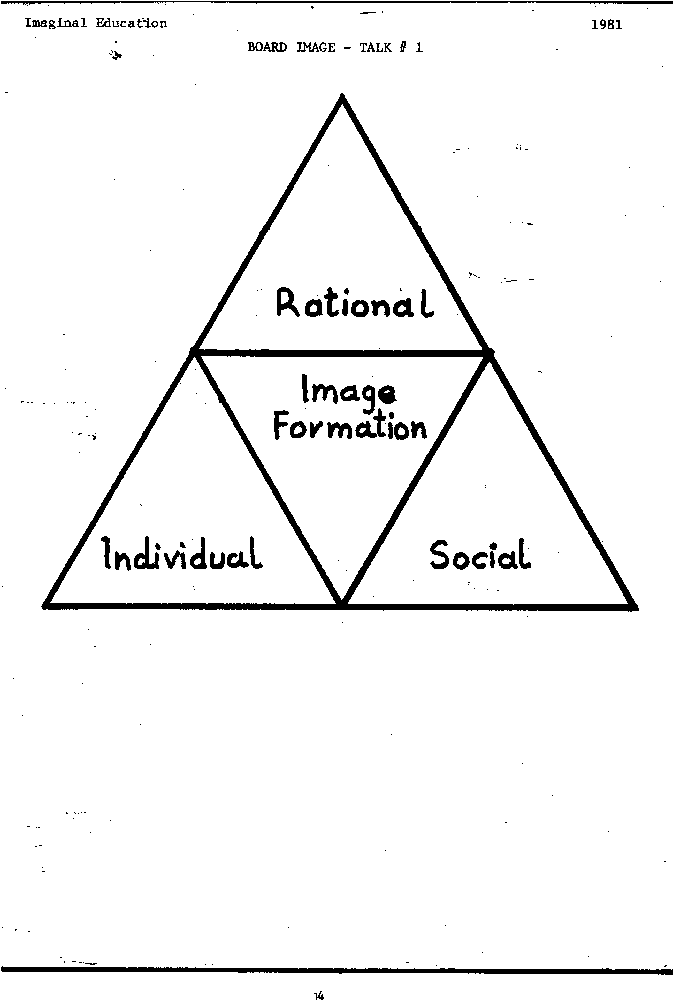
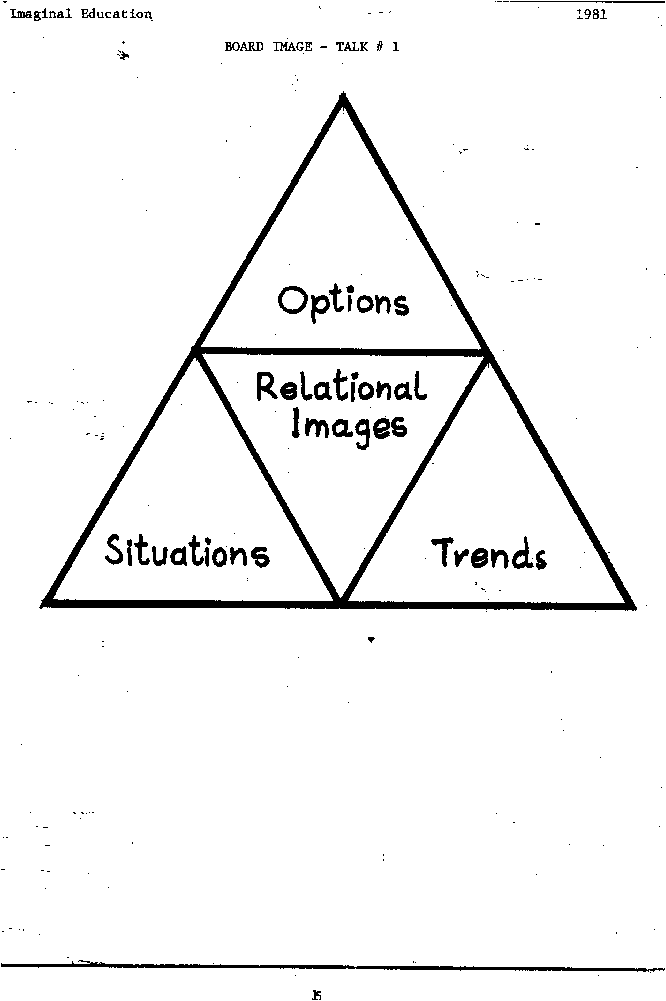
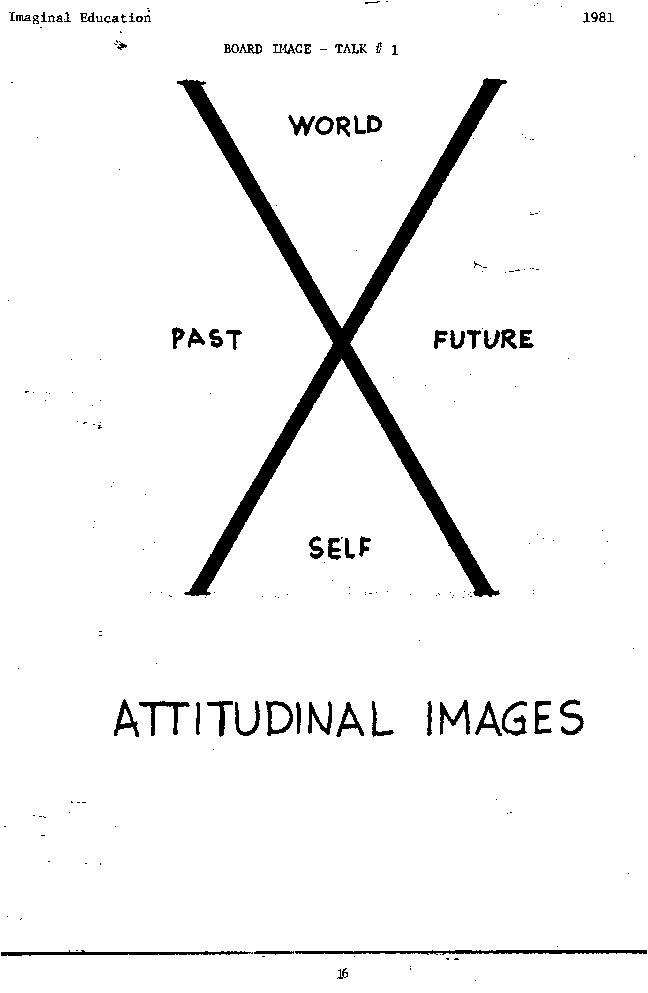 Imaginal Education 1981
Imaginal Education 1981
| RATIONAL OBJECTIVE: To see the images that
determine behavior and to discover messages that change, images. | EXISTENTIAL ADM: To experience the possibility of beaming messages (as trainers) that alter behavior. |
CONTEXT
We want to look at the images and messages that reinforce
old behavior and enable new behavior. Hand out "Image Change
Workshop" chart talk through the dynamics. Emphasize
the indirect messages: time (image of continuity/discontinuity),
space (decor, room setup), and relations (meetings, decision
making, role titles, etc.) Re-articulate examples of what happens
when we try to change behavior rather than images.
TEAM WORK
1. Divide into groups of 45 people based on similar working situations. (If appropriate for this course the same teams might work together for the whole time or could be a different mix each workshop.)
2. Fill in the chart using the working situation
that you are familiar with. (3060 minutes will be required)
The key is deciding the most crucial concrete "old behavior"
to work with for the whole chart.
TEAM REPORTS
1. Each team report.
2. 2 scribes take down notes on the board.
3. Reflect on the reports:
a. Which image struck the most responsive chord in you?
b. Which image would you like more clarity on?
c. Which message struck a responsive chord in you?
d. Which message would you like more clarity on?
e. As you look at the future messages, where will you meet resistance?
f. What values are you holding here?
g. Are there other ways you might send these messages?
h. If you had a direct message to give, what and how would you say it? (Remind group that it takes a radical
address in order to kill an old image)
GENERAL REFLECTION
1. What has shifted your image of training?
2. How might you use this/ would it be helpful?
3. Assign someone to type up the team reports for
the document.
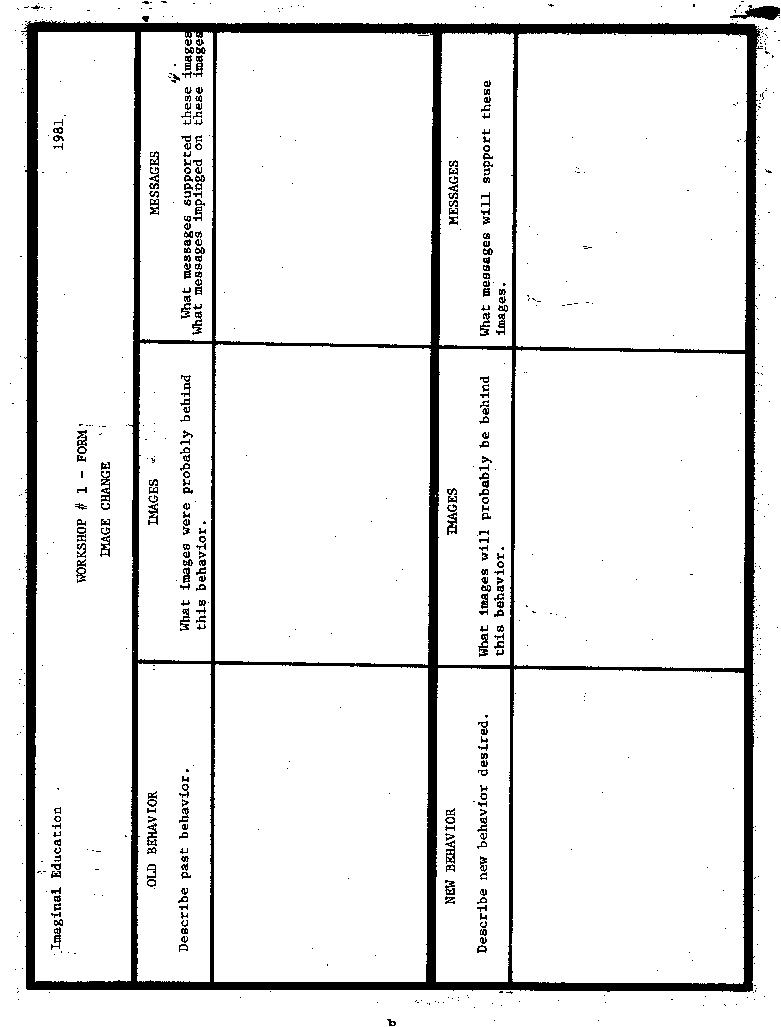 Imaginal Education 1981
Imaginal Education 1981
(Alternative or in addition to the Image Change Workshop)
The most important thing about studying a paper is to get hold of the patterns an structure that the author uses. This is to move beyond the content to what actually is in the author's mind.
1. Concentrate on the whole of the paper much as
you would a picture. This produces a gestalt for you.
a. Scan through the paper (or table of contents, if one.)
Look for the author's mayor breaks and subdivisions.
b. Run fingers through the paragraphs. See what words, enumerations, etc., Jump out at you.
c. Go through and number the paragraphs. Lay out the chart.
d. Read the conclusion, and the paragraphs before and after
the divisions.
e. Circle the important words.
f. Find key paragraphs where the structure and/or thesis is
laid out.
g. As yet you are not interested in content but only
the topical headings.
2. Relate the paragraphs and topics.
3. Read and sum up the paragraphs. Do not start necessarily with
the first paragraph, but those that get the topics up and the
structure out. Then complete all paragraphs.
4. Further relate the paragraphs and the topics to refine your
structure until a final gestalt comes.
. .
5. In your own words write a brief proposition stating
what is in each paragraph, each section of your structure and
finally for the whole paper.
6. Re-title the paper and topics in your own words
other than the author' s.
7. Relate the final topics and propositions to other
writers and your own selfunderstanding.
8. Analyze and criticize the author in relation to
#7.
An example of this procedure is shown. Charting should be done from left to right in order that your eye may help your mind grasp the structure.
-- The above method and example, which is detailed
for illustrative purposes, may look laborious, but actually saves
time. With a little practice the summaries can be shortened to
what is the important thing in the paragraphs and structures.
.
As I sit at my desk, I know where I am... I am not only located
in space, I am located in time... I am not only located in apace
and time, I located in a field of personal relations. I am not
only located in space and in time and in personal relationship,
I am also located in the world of nature, in a world of how things
operate... Finally, I am located in the midst of a world of subtle
intimations and emotions.
What I have been talking about is my Image of the world.
It is this image that largely governs, behavior. The first
proposition of this work. therefore. is that behavior depends
on the image.
What, however, determines the image? The image is built as a result
of all past experience of the possessor of the image. From the
moment of birth, if not before, there is a constant stream of
messages entering the organism from the senses. Every time a message
reaches him, his image is likely to be changed in some degree
by it, and as his image is changed his behavior pattern will be
changed likewise.
The meaning of a message is the change which it produces in the
image. When a message hits an image one of three things can happen.
In the first place, the image may remain unaffected. The second
possible effect or impact of a message on an image is that it
may change the image in some rather regular and welldefined
way that mightt be described as simple addition.
There is, however, a third type of change of the image which might
be described as a revolutionary change. Sometimes a message hits
some part of the nucleus or supporting structure in the image,
and the whole thing changes in a quite radical way.
The sudden and dramatic nature of these reorganizations is perhaps
a result of the fact that our image is in itself resistant to
change. When it receives messages which conflict with it,
its first impulse is to reject them as in some sense untrue.
One should perhaps add a fourth possible impact of the messages
on the image. They may also have the effect of clarifying it,
that is, of making something which previously was regarded as
less certain, more certain, or something which was
previously seen in a vague way clearer.
Messages may also have the contrary effect. They may introduce
doubt or uncertainty into the image.
The subjective knowledge structure or image of any individual
or organization consists not only of images of "fact"
but also images of "value".
The image of value is concerned with the rating of the
various parts of our image of the world, according to some scale
of betterness or worseness. We, all of us, possess one or more
of these scales. Moreover, we change these scales of valuation
in response to messages received much as we change our image of
the world around us.
One of the most important propositions of this theory is that
the value scales of an individual or organization are perhaps
the most important single element determining the effect of the
messages it receives on its image of the world. If a message is
perceived that is neither good or bad, it may have little or no
effect on the image. If it is perceived as bad or hostile to the
image which is held, there
THE IMAGE (continued)
will be resistance to accepting it. This resistance is not usually
infinite. An often repeated message or message which comes with
unusual force or authority is able to penetrate the resistance
and will be able to alter the image. A devout Moslem, for instance,
whose whole life has been built around the observance of the precepts
of the Koran will resist vigorously any message which tends to
throw doubt on the authority of his sacred word. The resistance
may take the form of simply ignoring the message or it may take
the form of emotive responses: anger, hostility, indignation.
In the same way, a "devout" psychologist will resist
strongly any evidence presented in favor of extrasensory perception,
because to accept it would overthrow his whole image of the universe.
If the resistances are very strong, it may take very strong or
often repeated messages to penetrate them, and when they are penetrated,
the effect is a re-alignment or reorganization of the whole knowledge
structure.
On the other hand, messages which are favorable, to the existing
image of the world are received easily and even though they may
make minor modifications of the knowledge structure, there will
not be any fundamental reorganization. Such messages may also
have the effect of increasing the stability, that is to say, the
resistance to unfavorable messages which the knowledge structure
or image possessee.
The stability or resistance to change of a knowledge structure also depends on its internal consistency and arrangement. There seems to be some kind of principle or minimization of internal strain at work which makes some images stable and other unstable for purely internal reasons.
Even at the level of simple or supposedly simple sense perception,
we are increasingly discovering that the message which comes through
the senses is itself mediated through a value system, through
a highly learned process of interpretation and acceptance.
What this means is that for any individual
organism or organization there are no such things as "facts".
There are only messages filtered through a changeable value system.
A group of individuals does not merely share messages which come
to them from "nature." They also initiate and receive
messages themselves. This is the characteristic which distinguishes
man from the lower organisms -- the art of conversation or discourse.
:
Knowledge grows also because of inward teachers as well as outward
messages. As every good teacher knows, the business of teaching
is not that of penetrating the student's defenses with the violence
or loudness of the teacher's messages. It is, rather, that of
cooperating with the student's own inward teacher whereby the
student's image may grow in conformity with that of the outward
teacher.
Imaginal Education 1981
MEAL OBJECTIVES:
| RATIONAL OBJECTIVE
To see changing images as a life process. | EXISTENTIALAIM
To experience the effectivity ofthe art form method in releasing new self understanding. |
CONTEXT
During this course we will jump into the ring and
then reflect on what happened to you. Ile will begin by singing.
We've all come from different jobs and situations that w~:'re
involved in during the day. We have found that singing together
helps to build a corporate arouD to move into the next task.
SONG
(Select a song appropriate to the group.)
RITUAL
Repeat after me: ACTION REMOVES THE DOUBT THAT THEORY
CANNOT SOLVE.
MEAL
Let us eat this meal on behalf of the Poets who provide
images for people to live authentically in their lives.
CONVERSATION
Art forms like stories, whether printed, vocal, or
visual, can be a great tool in offering new images. Listen to
this story.
Read, "LongHandled Broom."
| objective | 1. Words, scenes, characters
2. Describe what happened. |
reflective | 3. Where did the shifts take place in the story? Describe them. |
interpretive |
4. What decision was Emma demanding of the village? 5. What can be learned from this story about changing images? |
ANNOUNCEMENTS
SEND OUT
Repeat after me: ACTION REMOVES THE DOUBT....THAT
THEORY CANNOT SOLVE
Imagina1 Education 1981
Three weeks after the monsoon ended, the older people
in the village began to sweep out their own homes, the paths leading
from their houses to the road, and finally the road itself. This
sweeping was inevitably done by older people. They used a broom
made of palm fronds. It had a short handle, maybe two feet long,
and naturally they bent over as they swept.
One day, as Emma was watching the wrinkled and stooped
woman from the next house sweep the road, things fell into place.
She went out to talk to the woman.
"Grandmother, I know why your back is twisted
forward," she said, "It's because you do so much sweeping
bent over that short broom. Sweeping in that position several
hours a day gradually moulds you into a bent position. When people
become old their muscles and bones are not as flexible as when
they were young."
"Wife of the engineer, I do not think it is
so," the old lady answered softly. "The old people of
Southern Sarkhan have always had bent backs."
"Yes, and I'll bet that they all got them from
sweeping several hours a day with a shorthandled broom,"
Emma said, "Why don't you put a long handle on the broom
and see how it works?"
"Brooms are not meant to have long handles,"
the old lady said matteroffactly. "It has never
been that way. I have never seen a broom with a long handle, and
even if the wood were available, I do not think we would waste
it on long handles for brooms. Wood is very scarce in Chang Dong."
Emma knew when to drop a conversation. She had long ago discovered that people don't stop doing traditional things merely because they are irrational. She also knew that when people are criticized for an action, they stubbornly persist in continuing to do it.
:
The handles thSt Sarkhanese used for their brooms
came from a reed with a short strong stem about two feet long.
For centuries this reed had been used; and, centuries ago people
had given up looking for anything better. It was traditional for
brooms to have short handles, and for the brooms to be used exclusively
by people too old to work in the rice fields. But Emma wasn't
bound by centuries of tradition, and she began to look for a substitute
for the short handles.
One day she found what she was after. She was driving
the jeep down a steep mountain road about forty miles from Chang
Dong. Suddenly she jammed on the brakes. Lining one side of the
road for perhaps twenty feet was a reed very similar to the short
reed that grew in Chang Dongexcept that this reed
had a strong stalk that rose five feet into the air before it
thinned out.
"Homer," she ordered, "climb out and
dig me up a halfdozen of those reeds. But don't disturb
the roots."
When she got back to Chang Dong she planted the reeds beside her house and tended them carefully. Then, one day, when several of her neighbors were in her house she casually cut a tall reed, bound the usual coconut fronds to it, and began to
The Long Handled Broom p. 2
sweep. The women were aware that something was unusual, but for several
minutes they could not figure out what was wrong.
Then one of the women spoke. "She sweeps with
her back straight," the woman said in surprise. "I have
never seen such a thing."
Emma did not say a word. She continued to sweep right
past them, out on the front porch, and then down the walk. The
dust and debris flew in clouds; and everyone watching was
aware of the greater efficiency of being able to sweep while standing
up.
Emma, having finished her sweeping, returned to her
home and began to prepare tea for her guests. She did not speak
to them about the broom, but when they left, it was on the front
porch, and all of her guests eyed it carefully as they departed
The next day when Emma swept off her porch, there
were three old grandmothers who watched from a distance. When
she was finished Emma leaned her long handled broom against the
clump of reeds which she had brought down from the hills.
The next day, perhaps ten older people, including
a number of men, watched Emma as she swept. This time when she
was finished, an old man, his back bent so that he scurried with
a crablike motion, came over to Emma.
"Wife of the engineer, I would like to know
where I might get a broom handle like the one you have,"
the man said, "I am not sure that our shorthandled
brooms have bent our backs like this but I am sure that your way
of sweeping is a more powerful way."
Emma told him to help himself to one of the reeds~growing
beside the house. The old man hesitated.
"I will take one and thank you; but if I take
one, others may also ask, and soon your reeds will be gone."
"It is nothing to worry about, old man,"
_mma said. "There are many such reeds in the hills. I found
these by the stream at Nanghsa. Your people could walk up there
and bring back as many as the village could use in a year on the
back of one water buffalo." The old man did not cut one of
Emma's reeds. Instead he turned and hurried back to the group
of older people. They talked rapidly, and several hours later
Emma saw them heading for the hills with a water buffalo in front
of them.
Soon after, Homer completed his work in Chang Dong,
and they moved to Rhotok, a small villageabout seventy miles
to the east. And it was not until four years later, when Emma
was back in Pittsburgh, that she learned the final results of
her broom handle project. One day she got a letter in a large
handsome yellowbamboo paper envelope. Inside, written in
an exquisite script, was a letter from the headman of Chang Dong:
LongHandled Broom pg 3
Wife of the engineer: I am writing you to
thank you for a thing that you did for the old people of Chang
Dong. For many centuries, longer than any man can remember, we
have always had old people with bent backs in this village. And
in every village that we know of the old people have always had
bent backs.
We had always thought this was a part of growing old, and it was one of the reasons that we dreaded old age. But, wife of the engineer, you have changed all that. By the lucky accident of your longhandled broom you showed us a
new way to sweep. It is a small thing, but it has
changed the lives of our old people. For four years, ever since
you have left, we have been using the long reeds for broom handles.
You will be happy to know that today there are few bent backs
in the village of Chang Dong. Today the backs of our old people
are straight and firm. No longer are their bodies painful during
the months of the monsoon.
This is a small thing, I know, but for our people
it is an important thing.
I know you are not of our religion, wife of the engineer,
but perhaps you will be pleased to know that on the outskirts
of the village we have constructed a small shrine in your memory.
It is a simple affair; at the foot of the altar are these words:
"In memory of the woman who unbent the backs of our people."
And in front of the shrine there is a stack of the old short reeds
which we used to use.
_
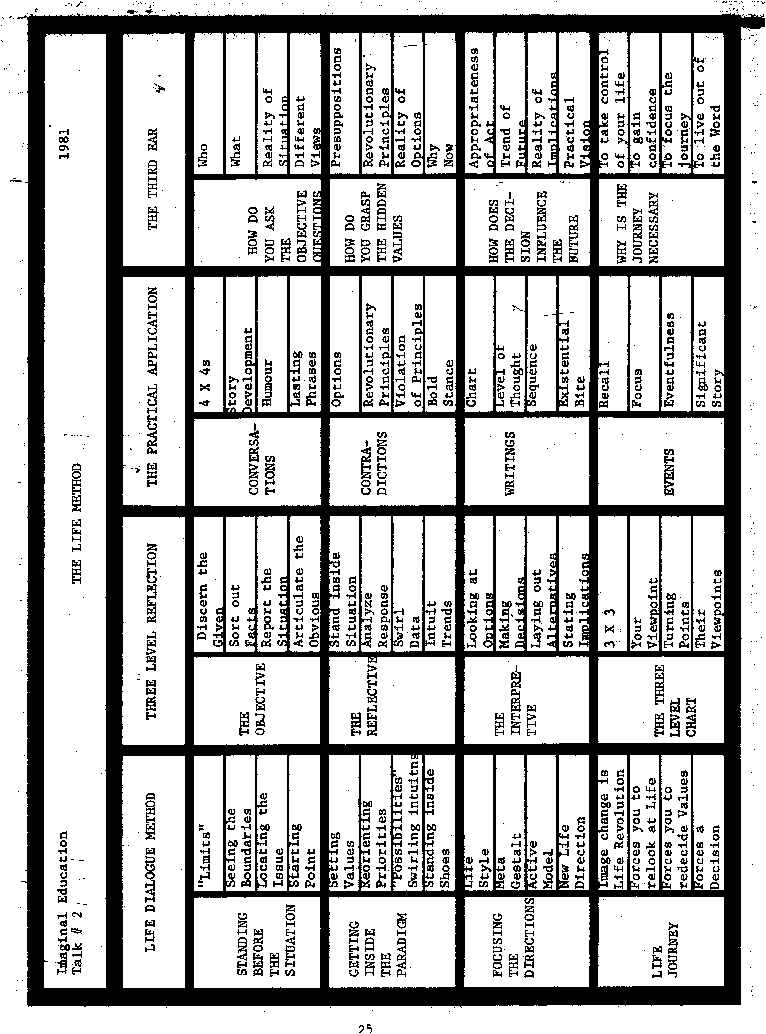 Imaginal Education l981
Imaginal Education l981
A. LIFE DIALOGUE METHOD
Dialogue is only possible when one i8
ready to hold all aspects of the process of
thinking before you. Standing before the situation enables you
to set the parameters of your subject. It is the starting point
or the "Limits". The second step is to get inside the
value screen or the paradigm of the situation. This is swirling
the "possibilities". The 3rd set is focusing the directions
with an active model. This is determining the "life style
of freedom" Finally, this dialogue method is not only the
only one for a particular situation. It is your life journey that
goes through this method: looking and looking at your life; deciding
and re-deciding your values; and choosing and re-choosing your
acti
B. THREE LEVEL REFLECTION
The 3 steps in this method of dialogue, or reflection
on the inward journey are: the objective, which is to discern
the given; the Reflective, which is to stand inside the situation;
and the Interpretive, which is looking at the options. This 3
level chart that I am putting on the board are various questions
one can askoneself when writing out a possible conversation.
The first level reflects your most immediate viewpoint; the second
level down reflects turning points or historical examples; and
the 3rd level down reflects the viewpoints of others.
C. THE PRACTICAL APPLICATION
If you use these methods in several situations you begin to see how they help to determine the appropriateness of your activity. In conversations, it is a method for rationally thinking through the necessary steps to cover in a conversation. In Contradictions, it enables you to see the revolutionary principles you operate out of, the principles you give up and the bold stance that exists in each option. In writings, it clarifies your sequence of thought and provides the existential bite. In Events, it gives you a method to recall the happenings
of the event and to reveal the significance.
D. THE THIRD EAR
We have always known that it is as important to listen to the context as well as the content in order to understand what is said. One way to train yourself on how to do that is to listen for the imbalance in the triangle. Those who jump to conclusions are those who go straight to the interpretive without looking at the objective data or the reflective values. Those who depend on personality to make a point are stuck on the reflective values without looking at the objective
data or the interpretive decision. Those that are
afraid to move: until all the data is in are those stuck on the
objective and will not look at the values or the decisions required.
All three steps are necessary to operate comprehensively. This
triangle enables you to take control of your life in terms of
the objective limits; to gain confidence in your life in terms
of the possibilities; and to focus your priorities into one thrust
in terms of your life style.
** Although this is not pointed out in the Imaginal Education Course, this life method is based on the situation the "Father" gives us, the promise the "Son" gives us, and the demand to take our freedom that the "Holy Spirit" gives us. This method is therefore based on a life method (that which gives us humanness) and thus that which is theologically grounded. In some preschool manuals you will sometimes see a fourth level. This level, which is to ground your conversation in theological or mythological language is not a fourth level, but the 3rd part of the 3rd level.
Imagina1 Education 1981
Some lands are flat and greencovered, and smile so evenly up at the sun that they seem forever youthful, untouched by man or time. Some are torn, ravaged and convulsed like the features of profane old age. Rocks are wrenched up and exposed to view; black pits receive the sun but give back no light.
It was to such a land I rode, but I rode to it across a sunlit, timeless prairie over which nothing passed but antelope or a wandering bird on the verge where that prairie halted before a great wall of naked sandstone and clay, I came upon the Slit. A narrow crack worn by some descending torrent had begun secretly, far below the prairie grass, and worked itself deeper and deeper into the fine sandstone that led by devious channels into the broken waste beyond. I rode back along the crack to a spot where I could descend into it, dismounted, and left my horse to graze.
The crack was only about bodywidth, and as I worked my way downward, the light turned dark and green from the overhanging grass. Above me the sky became a narrow slit of distant blue, and the sandstone was cool to my hands on either side. The Slit was a little sinister like an open grave, assuming the dead were enabled to take one last look for over me the sky seemed already as far off as some future century I would never see.
I ignored the sky, then, and began to concentrate on the sandstone walls that had led me into this place. It was tight and tricky work, but that cut was a perfect cross section through perhaps ten million years of time. I hoped to find at least a bone, but I was not quite prepared for the sight I finally came upon. Staring straight out at me, as I slid farther and deeper into the green twilight, was a skull embedded in the solid sandstone. I had come at just the proper moment when it was fully to be seen, the white bone gleaming there in a kind of ashen splendor, water worn, and about to be ground away in the next long torrent.
It was not, of course, human. I was deep, deep below the time of man in a remote age near the beginning of the reign of mammals. I squatted on my heels in the narrow ravine, and we stared a little blankly at each other, the skull and I. There were marks of generalized primitiveness in that low, pinched brain case and grinning jaw that marked it as lying far back along those converging roads where, as I shall have occasion to establish elsewhere, cat and man and weasel must leap into a single shape.
It was the face of a creature who had spent his days following
his nose, who was led by instinct rather than memory, and whose
power of choice was very small. though he was not a man, nor a
direct human ancestor, there was yet about him, even in the bone,
some trace of that low, snuffling world out of which our forebears
had so recently .emerged. The skull lay tilted in such a manner
that it stared, sightless, up at me as though I, too, were already
caught a few feet above him in the strata and, in my turn, were
staring upward at that strip of sky which the ages
were carrying farther away from me beneath the tumbling
debris of falling mountains. The creature had never lived to see
a man, and I, what was it I was never going to see.
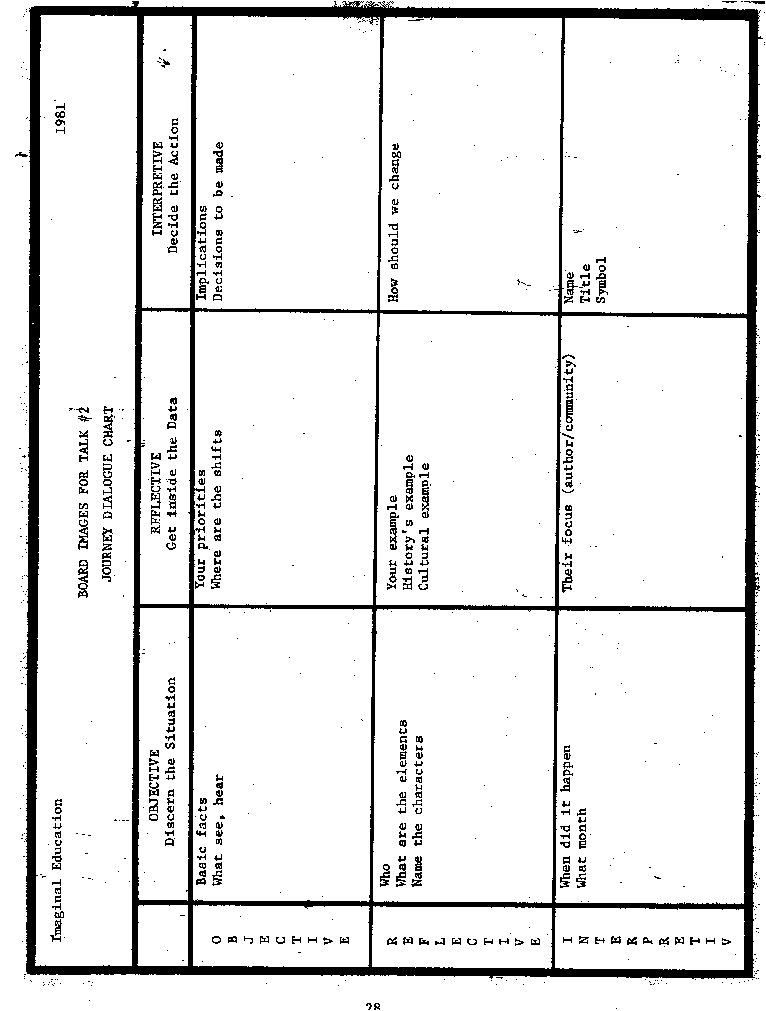
Imaginal Education 1981
| RATIONAL OBJECTIVE: To practice the life method of reflection | EXISTENTIAL ADM: To see the possibility of reflecting indepth in any situation |
CONTEXT
We want to create an art form conversation using
the dynamics of dialogue ______ talked about in the talk. Hand
out "Journey Dialogue" charts. Briefly walk through
the dynamics of the 3 X 3. The 1st chart will be to hold our initial
brainstorm work. The 2nd chart is for the final draft of our conversation.
TEAM ASSIGNMENTS
1. Break into groups of 45 people. (Either the same teams as in session 1 or a new configuration with common working situations. A bank president and a school teacher on the same team will not be helpful.)
2. Whole group decide on arenas for their conversations, like:
a. a conversation on a work situation.
b. a way of discerning a contradiction or block that they are
dealing with.
c. writing a proposal on a particular subject.
d. reflecting on an event (choose subject)
e. art form conversation on an awe object or a story reflection
(choose subject.)
TEAM WORK
1. Construct a conversation dealing with your arena using first the brainstorm form and
then the conversation form.
2. Work with the Rational Objective and Existential Aim first.
3. Take 45 minutes for this work and appoint a scribe to record the final selection of
questions.
TEAM REPORTS
1. Each team report (if time is a factor you may ask just for highlights from their work)
2. Are there questions of clarity on the reports?
3. Which questions or lines most struck you? (you want 1015 answers)
4. Look at each report and ask: Which images will
be changed as the result of this work?
REFLECTION
1. What has shifted your image since the beginning of this session
(including the talk)
2. How will this session be useful how might you use it?
3. What was most helpful in this session? leas helpful?
4. Assign someone to type up the reports.
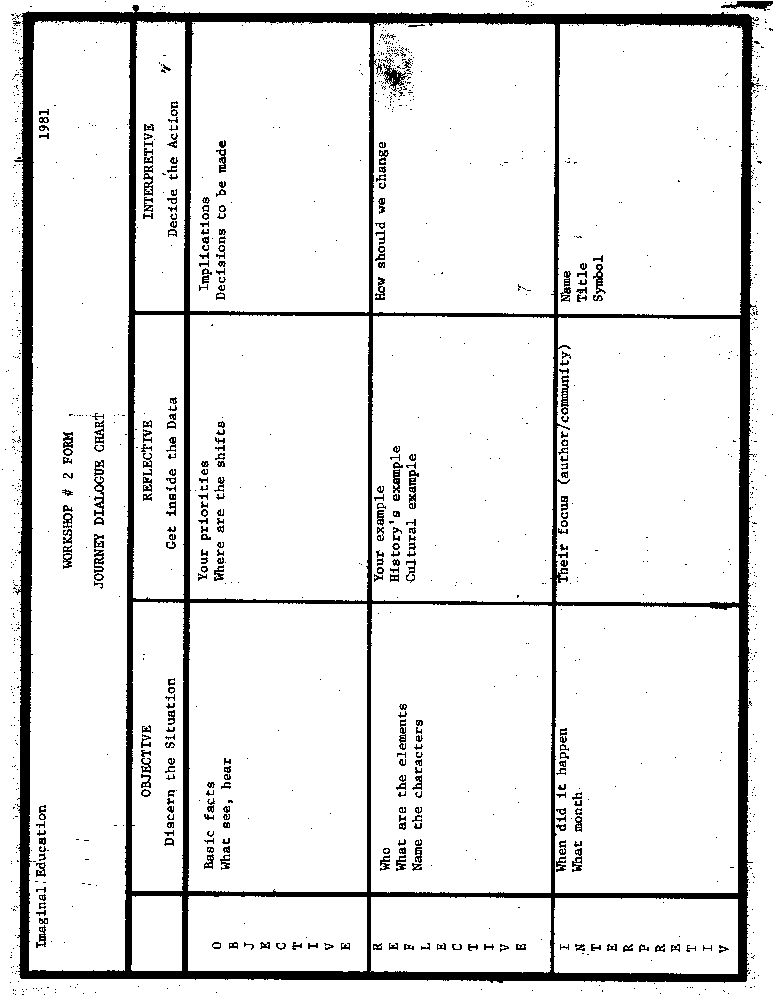
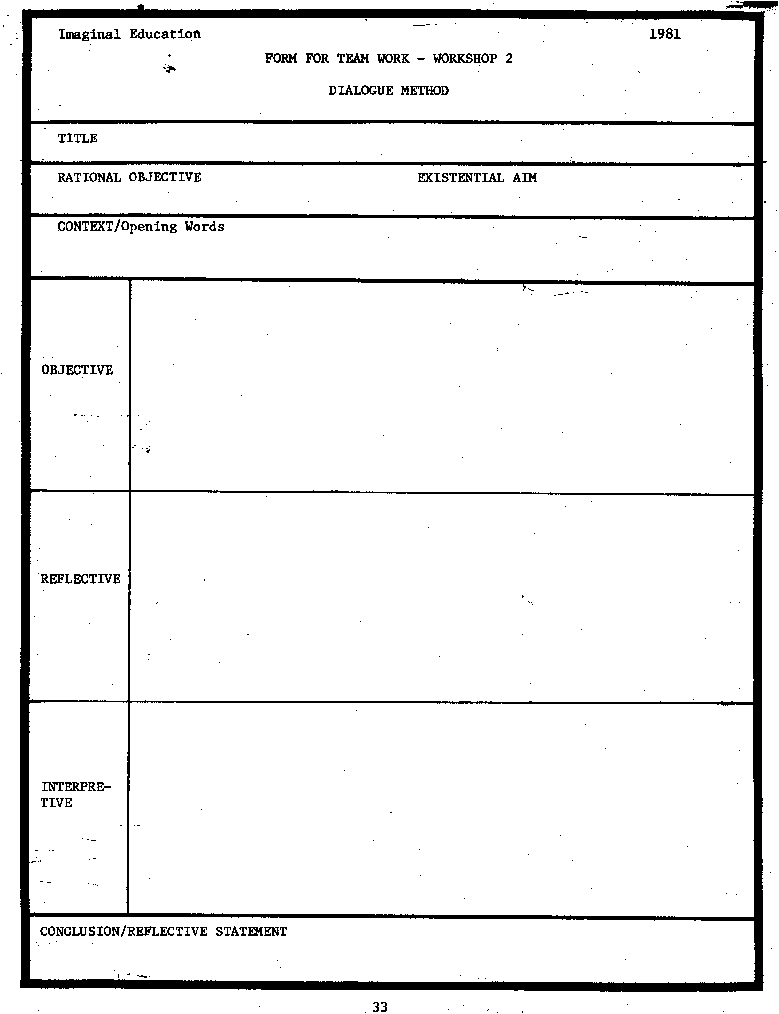
BOARD IMAGE FOR TALK # 2 .
OBJECTIVE REFLECTIVE INTERPRETIVE
Imaginal Education 1981
` BOARD IMAGE TALK #2
